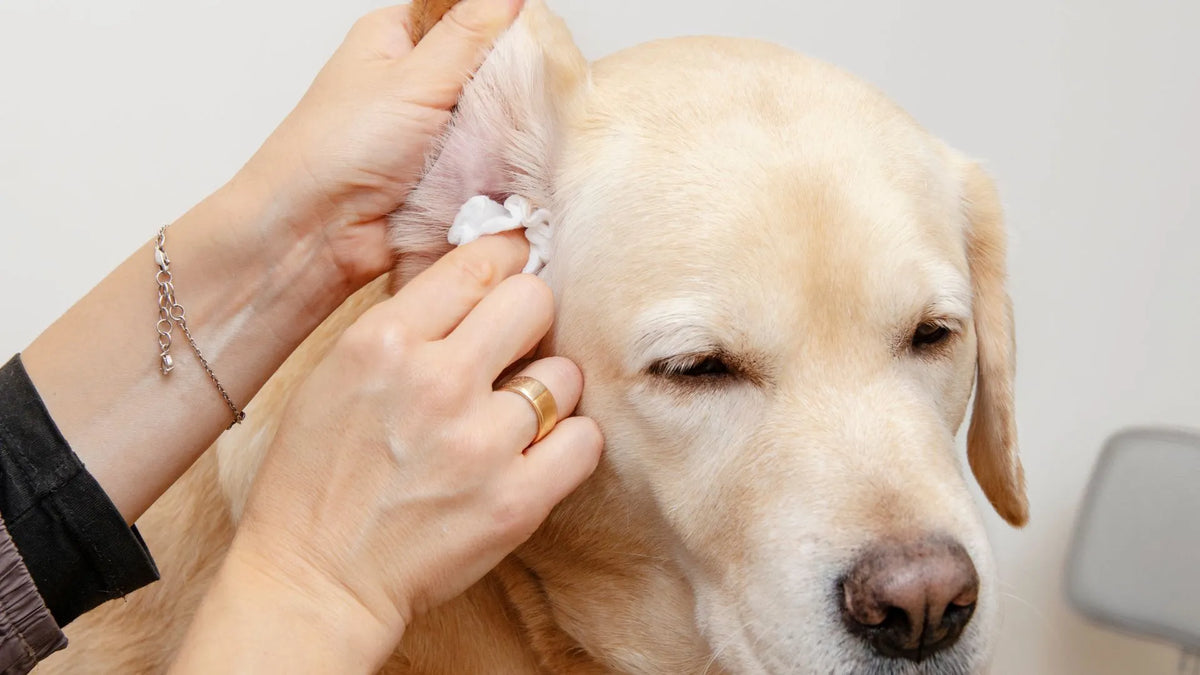In 24 cities

A Comprehensive Guide to Cleaning Your Dog's Ears: Tips and Techniques for Pet Parents
|
|
Time to read 7 min
Get product availability and delivery timelines based on your location.
Are you sure you want to delete this address?
Help us ensure a smooth delivery
Help us ensure a smooth delivery
SIZE GUIDE
|
|
Time to read 7 min
As a loving pet parent, you want the best for your furry companion. While we often focus on grooming, feeding, and playtime, ear health is an area that sometimes gets overlooked. Your dog's ears are not just cute accessories; they play a vital role in their overall well-being. Just like you check your own ears, it’s important to ensure your pup's ears are clean and healthy.
Cleaning your dog’s ears might sound like a daunting task, especially if you've never done it before. But don’t worry! With a little knowledge and the right approach, you can make this a simple and enjoyable part of your dog's grooming routine. Whether your dog has floppy ears that trap moisture or erect ears that collect dust, understanding how to clean them properly can help prevent infections and other ear-related issues.
In this guide, we'll walk you through everything you need to know about cleaning your dog’s ears—from when to clean them and the signs they need attention to the essential supplies you'll need. Let’s dive in and ensure those adorable ears stay healthy and happy!
Just like you regularly maintain your own hygiene, your dog needs some TLC for their ears, too. Regular ear cleaning can help prevent ear infections and other health issues. Here are some reasons why it’s crucial:
Determining when to clean your dog’s ears depends on several factors, including their breed, lifestyle, and overall health. Here are some guidelines to help you decide:
Being proactive in monitoring your dog’s ear health can prevent serious issues down the line. Here are some signs that your dog’s ears may need more than just a routine cleaning:
Having the right tools on hand makes ear cleaning easier and safer for both you and your dog. Here’s a list of essential supplies you should gather before you start:
Cleaning your dog’s ears can seem daunting, especially if it's your first time. But with a little patience and the right approach, it can be a positive experience for both of you. Follow these steps:
Find a quiet, comfortable space where you and your dog can relax. If your pup is nervous, consider having someone help hold them gently. It’s essential to make them feel secure and calm.
Before you start cleaning, take a moment to inspect your dog’s ears for any redness, swelling, or excessive wax. If you see any concerning signs, it’s best to consult your vet.
Gently massage the base of your dog’s ear for about 20 to 30 seconds. This step helps to loosen any dirt or wax buildup. You might hear a squishy sound as the cleaner moves around.
Allow your dog to shake their head. This natural behavior helps expel the cleaner and loosen debris. Be ready for a little mess—it's all part of the process!
Using a cotton ball or pad, gently wipe the visible part of the ear canal. Avoid pushing anything deep into the ear, as this can cause injury. Repeat the wiping process until the cotton comes out clean.
Once you finish, don’t forget to reward your furry friend with praise or a treat. This positive reinforcement will help them associate ear cleaning with a pleasant experience.
While cleaning your dog’s ears may seem straightforward, there are common mistakes that can lead to complications. Here are some to watch out for:
While regular ear cleaning is essential, there are times when it’s crucial to seek professional help. Here are some scenarios where you should call your vet:
Cleaning your dog’s ears is not just a grooming task; it's an essential part of maintaining their overall health and well-being. Regular ear cleaning can help prevent infections and catch potential issues early, ensuring your furry friend remains comfortable and happy. Remember, the process should be gentle and stress-free, creating a positive experience for both you and your pup.
If you ever feel unsure about how to clean your dog’s ears or if you notice any signs of discomfort, don't hesitate to consult your veterinarian. They can provide personalized advice and may offer professional cleaning services if necessary.
And if you’re looking for resources or products to help you with dog care, there are great options available at Supertails. We have a range of products that can assist you in keeping your furry friend healthy and happy. Enjoy the bonding moments during ear cleaning, and keep your pup’s ears happy and healthy!
1. How often should I clean my dog’s ears? The frequency of cleaning depends on your dog's breed and lifestyle. Generally, it’s good to check their ears monthly and clean them as needed.
2. Can I use human ear cleaning products? No, you should only use vet-approved ear cleaners made specifically for dogs.
3. What should I do if my dog resists ear cleaning? Take your time and make it a positive experience. Use treats and soothing words to help them feel secure.
4. Is ear cleaning necessary for all dogs? Not all dogs need frequent ear cleaning. Dogs with upright ears typically require less attention than those with floppy ears.
5. What if I notice signs of an ear infection? If your dog shows signs of an ear infection, such as redness, odor, or discomfort, contact your veterinarian for advice and treatment.
2 item in cart
₹10,360

